
AI-Powered Optimization
for Container & White Glove Logistics
XGBoost, GPT, and OCR models working together to streamline high-complexity logistics.
Siliconmint partnered with a U.S. logistics provider to transform their
transportation network for container and premium last-mile deliveries. The platform
manages the flow of goods from sea ports to warehouses, between distribution hubs,
and directly to end-customers — supporting both industrial-scale freight and
high-touch white glove services.
Download PDFBusiness Challenge
The client faced several critical issues in managing container and specialized deliveries across the U.S.:
To remain competitive, the client required a platform capable of dynamically sourcing available drivers and vehicles, minimizing idle time, and automating complex route and delivery decisions.
Driver and Truck Availability:
A recurring problem was the inability to quickly locate and assign available trucks and drivers for container pickup at sea ports. Containers often remained idle at terminals or port-side warehouses, incurring storage fees and causing downstream delays.Idle Container Costs:
Delays in finding transportation resulted in long dwell times for containers, leading to increased demurrage charges and inefficient asset utilization.Lack of Real-Time Coordination:
The legacy systems lacked real-time insight into port schedules, traffic, or vehicle availability, which made proactive planning impossible and introduced bottlenecks across the delivery chain.Diverse Delivery Requirements:
The company needed a unified solution that could serve not only industrial-scale container logistics, but also handle white glove delivery scenarios — where precise timing, handling, and customer experience are essential.Technical Challenge
The core technical challenge was to build a logistics platform that could intelligently track, predict, and coordinate the availability of freight drivers — effectively orchestrating deliveries in real time. This required solving several deep operational and engineering problems:
Dynamic Driver Availability Tracking:
Identify which drivers are currently active, who will be available later, and who might drop out — using real-time app signals and historical behavior patterns.Disruption Response & Reallocation:
Automatically handle no-shows, early/late arrivals, and last-minute cancellations — and reassign tasks without human bottlenecks.AI-Assisted Dispatcher Operations:
Provide dispatchers with AI assistance for interpreting free-text updates from drivers, generating responses, and flagging operational issues.Document Processing & Validation:
Process and validate proof-of-delivery documents, customs paperwork, and gate passes via AI — with OCR and field extraction.Model definitions
| Model Name | Architecture | Provider | Purpose | Input | Output | Usage Context |
|---|---|---|---|---|---|---|
DriverPredict-XGB | XGBoost (Gradient Boosting Trees) | Custom (in-house) | Predicts driver availability based on historical behavior and app data | Driver ID, activity history, shifts, app pings | Availability probability for time slots | Used in planning to pre-allocate or reassign deliveries |
| DispatchGPT | Large Language Model (GPT-4 Turbo) | OpenAI | Interprets driver messages, suggests replies, flags risk | Free-text message, dispatcher context | Suggested response, summarized intent, risk flags | Live assistant in dispatcher UI |
DocOCR-Validator | TrOCR + LayoutLMv3 | Microsoft / HuggingFace | Processes and validates delivery documents | Scans, PDFs, images | Structured data, validation results, compliance status | Document processing for proof-of-delivery and compliance workflows |
Model Runtime Characteristics
| Model Name | Avg Inference Time | Retraining Frequency | Context Volume | Explainability | Real-Time Compatible |
|---|---|---|---|---|---|
DriverPredict-XGB | ~200 ms | Weekly | ~50 variables (driver activity patterns) | SHAP feature importance | Yes |
| DispatchGPT | ~500–700 ms | N/A (prompt-based) | ~300–500 tokens (text + metadata) | Natural-language explanation (LLM) | Yes |
DocOCR-Validator | ~2–3 sec | Rare (base models), rules updated quarterly | ~1 document page (image + form structure) | Partial (OCR confidence + heuristics) | Batch or async preferred |
Model Comparison for Dispatcher Assistant
| Model | Response Time | Output Quality | Strengths | Weaknesses |
|---|---|---|---|---|
GPT-4 Turbo (Chosen) | ~500–700 ms | High (natural, contextual, actionable) | Fast, cost-effective, highly contextual | Limited to ~128k tokens; sometimes verbose |
| GPT-4 (original) | ~2–3 sec | Very High (nuanced, detailed, reliable) | Deep understanding, great in edge cases | High latency and cost for frequent UI interactions |
DriverPredict Model Comparison
| Model Name | Accuracy | Training Time | Inference Time | Explainability | Strengths | Weaknesses Time |
|---|---|---|---|---|---|---|
XGBoost (Chosen) | High (great for structured behavioral data) | Fast | ~200 ms | SHAP feature importance | Interpretable, robust, effective for tabular data | May need manual feature engineering |
| LightGBM | Comparable to XGBoost | Very fast | ~150 ms | SHAP | Fast training, scalable on large datasets | Slightly harder to tune for accuracy |
Temporal Fusion Transformer | Very high for time-series | Slow | ~1–2 sec | Attention-based insights | Captures time dependencies, interpretable via attention | Complex infra, slow inference, overkill |
Tech Stack

GPT-4 Turbo

XGBoost
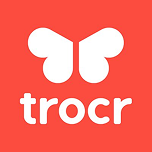
TrOCR

LayoutLMv3

Node.js

Express js

GraphQL

React

MongoDB

PostgreSQL
![[object Object]](/images/common/tech/aws.svg)
AWS
(ECS, Fargate, Lambda)
(ECS, Fargate, Lambda)
How Was AI Integrated?
The platform primarily operates as a logistics marketplace, where drivers — either independently or via affiliated companies — browse and accept freight assignments directly through the app. To ensure reliability, especially during peak load times or when certain shipments were not picked up, the company also maintained a pool of internal and contracted drivers who could fill the gaps.
In earlier stages, when a shipment remained unassigned or was at risk of delay, dispatch managers would manually reach out to drivers, remind them to log in, or negotiate urgent coverage. While effective, this workflow placed a heavy burden on the operations team.
To reduce that load, AI was gradually introduced — starting with the most repetitive and scalable processes.
Phase 1
Handling Driver Inquiries and Documents
The first use case for AI was to answer frequently asked questions from drivers, such as:
- “Where do I drop off the container?”
- “What documents are needed at pickup?”
- “Is the terminal open before 7am?”
These questions were common and predictable, though phrased in slightly different ways. Using GPT-4 Turbo, we trained an assistant to handle them based on historical driver-dispatcher conversations. For document-related queries, the AI also leveraged OCR and document understanding models (TrOCR + LayoutLMv3) to extract key data from uploaded scans or images.
This freed up dispatchers from a high volume of routine messages and reduced driver response time significantly.
Phase 2
Predicting Assignment Gaps Before They Happen
Next, we focused on a more strategic application: helping managers detect in advance when a delivery might not be picked up through the marketplace.
A predictive model was trained to identify patterns in regions, load types, and time windows where assignments historically fell through. Instead of waiting until the last moment, the system could now surface shipments with a high likelihood of going unclaimed — even if the deadline hadn’t passed.
This enabled the platform to:

Send proactive reminders to drivers

Notify a manager to intervene early

Suggest fallback options from the internal driver pool
By doing so, the system helped minimize disruptions and gave dispatchers more time and flexibility to act — turning reactive triage into proactive planning.
With AI embedded into day-to-day workflows, the platform now offloads a large portion of repetitive operational tasks:

Answers driver questions automatically via AI assistant

Interprets documents and extracts key delivery details

Identifies high-risk assignments early based on patterns and rules
This shift allows managers to:

Focus on exceptions that require human judgment

Make more strategic decisions, not micromanage the routine

Trust the system to handle predictable, repeatable tasks
Our Solution
We delivered a modular, AI-driven logistics platform optimized for real-time container and white glove coordination. Key components include:
DriverPredict-XGB
A predictive model (XGBoost) that forecasts driver availability using real-time telemetry, app usage, and historical shift patterns.
Driver Availability
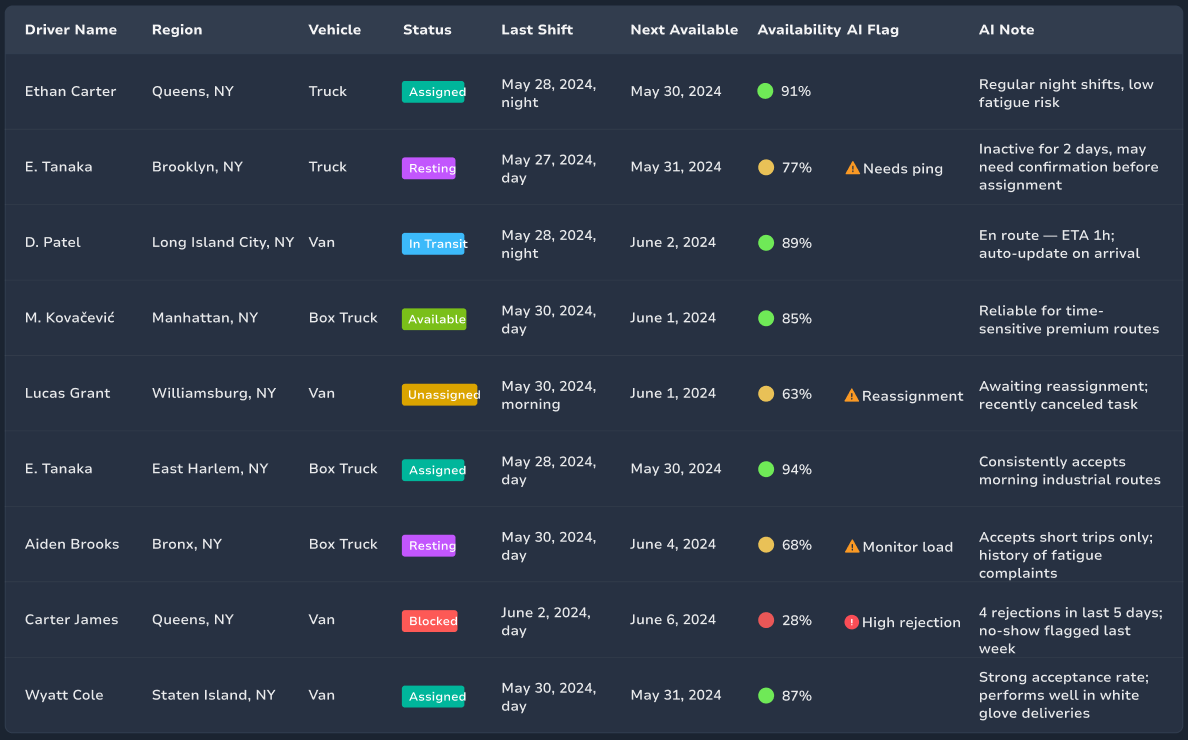
DispatchGPT (GPT-4 Turbo)
An LLM-powered assistant that helps dispatchers interpret driver messages, suggest responses, and recommend reassignment actions.
Dispatch AI Assistant
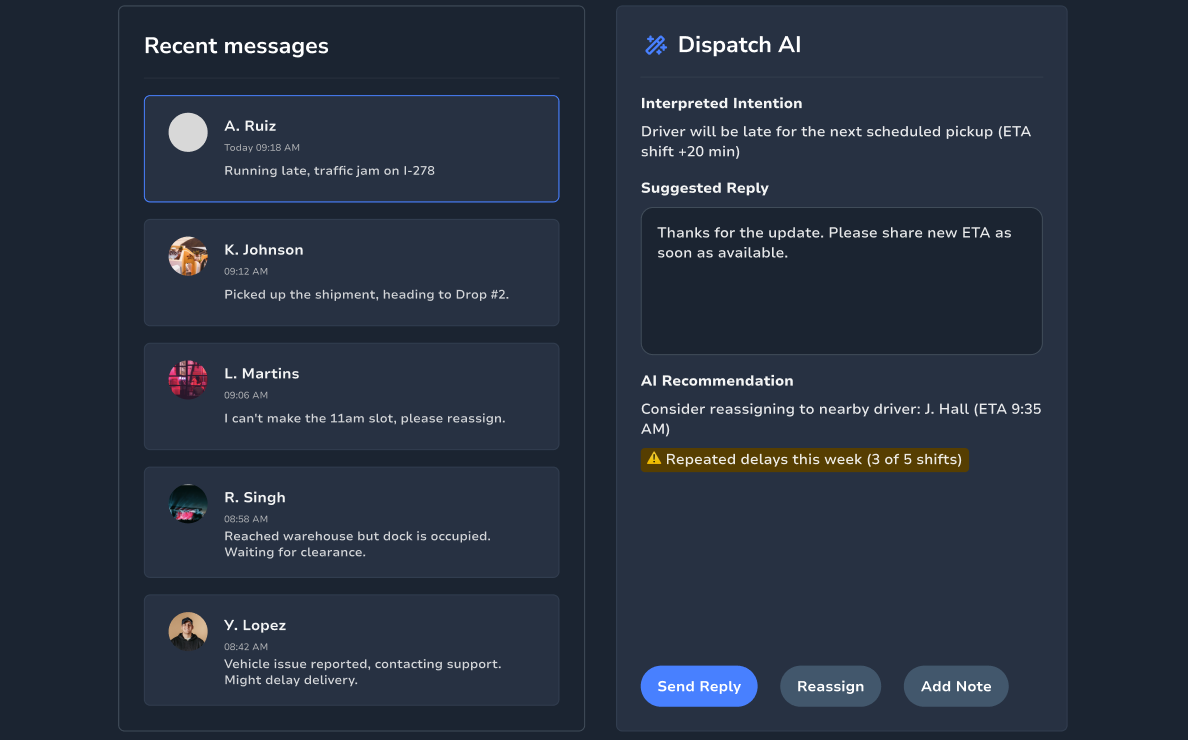
Smart Reallocation Engine
Combines rule-based logic with reinforcement learning to dynamically reassign shipments based on real-time availability and delivery windows.
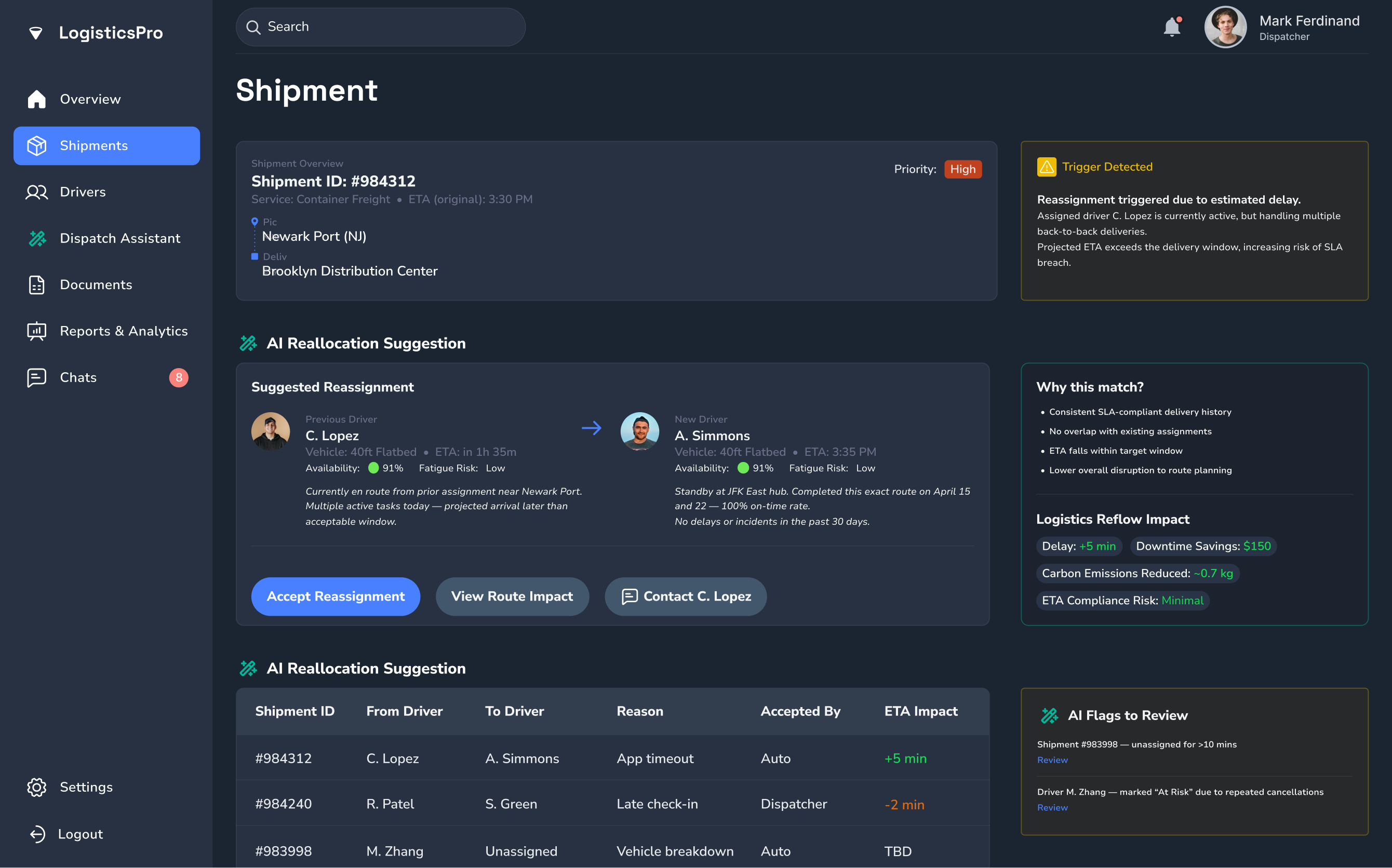
DocOCR-Validator
A document-processing pipeline built on TrOCR + LayoutLMv3 for extracting and verifying fields in delivery documents and compliance forms.
Extracted Fields Panel

Scalable Architecture
Backend (Node.js, GraphQL, AWS, PostgreSQL + MongoDB) and frontend (React) support large-scale dispatching and operator control.
System Overview
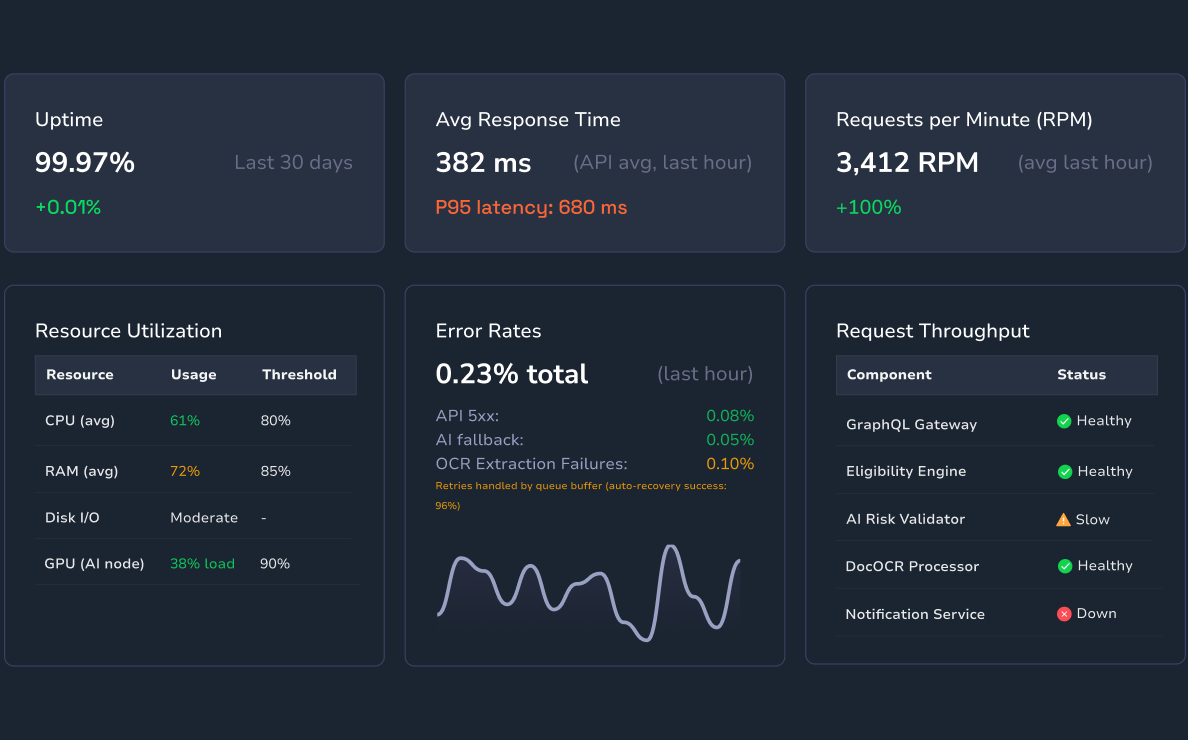
Impact
Up to 95% automation
of route and assignment planning99% on-time pickup
and delivery across 500,000+ annual shipments3x improvement in SLA adherence
for white glove deliveries70% boost in operational efficiency
for container transport30% fewer idle/empty miles
reducing logistics overhead and CO₂ emissions>90% automation
in document verification and compliance handling


Get in touch
To discuss your development needs
Attach files
Send me an NDA
Attach files
or drag & drop files here
Send me a SiliconMint NDA
Send
